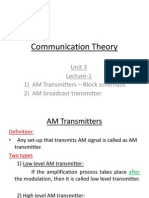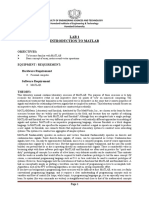Logarithmic Functions
Uploaded by
hwangceo25Logarithmic Functions
Uploaded by
hwangceo25Introduction to Logarithms
Logarithm is the other way of writing the exponent. It is basically the power of any number.
Definition: Let a, x , y be real numbers such that a > 0 and a≠ 1, the logarithm of x to the base a is y and is
written loga x = y, if and only if x = ay ,
Reminders:
1. In both the logarithm and exponential forms, b is the base. In the exponential form, c is an exponent; this
implies that the logarithm is actually an exponent. Hence, logarithmic and exponential functions are
inverses.
2. In the logarithmic form log b x , x cannot be negative.
3. The value of log b x can be negative.
Common Logarithms are logarithms with base 10, log x is a short notation for log 10 x .
Natural Logarithms are logarithms to the base e (approx. 2.71828), and are denoted by “ln”. In other words, lnx is
another way of writing log e x .
Activity 1: Rewrite the following logarithmic equations in exponential form.
1. log3 9 = 2 ans. 32 = 9
2. log5 1 = 0 50 = 1
1
3. log16 4 = (16)1/2 = 4
2
1
4. log1/2 8 = -3 ( ¿-3 = 8
2
5. log 10000 = 4 104 = 10000
6. ln 5 = x ex = 5
Activity 2: Rewrite the following exponential equations in logarithmic form, whenever possible.
1. 23 = 8 log2 8 = 3
2. 45 = 1024 log4 1024 = 5
1 1
3. 5-4 = log5 = -4
625 625
4. 72 = 49 log7 49 = 2
2 16 log 2 16 = 4
5. ( )4 =
3 81 3 81
Activity 3: Find the value of the following logarithmic expressions.
1. log 9 729 ans. 3 3. log 2 32 ans. 5 5. log 2(−8) undefined
1
2. log 5 ans. -3 4. log 1 16 ans. -4
125 2
Formative Assessment:
A. Express the given equations in logarithmic forms and write your answer in your answer sheet.
1. 53 = 125
1
2. 7-2 =
49
3. 102 =100
1 −4
4. ( ¿ ¿ = 81
3
5. ex = 8
B. Express the given equations in exponential form and write your answer in your answer sheet.
1
1. log4 2 =
2
1
2. log ( ) = -3
1000
8
3. log 2 ( ) = 3
3 27
4. log7 1 = 0
5. ln 8 = a
C. Find the value of the following logarithmic expressions.
1. log 1,000, 000
2. log3 81
3. log 1 16
4
4. ln ex
5. log3 1
General Mathematics (agclementir) Page 1 of 3
Logarithmic Functions, Equations, and Inequalities
Logarithmic Equation Logarithmic Inequality Logarithmic Function
Definition An equation involving An inequality involving Function of the form
logarithms. logarithms. f (x)=log b x (b>0, b≠1)
Example log x 2=4 2
ln x > ( ln x )
2
g ( x )=log 3 x
Determine whether the given is a logarithmic function, a logarithmic equation, a logarithmic inequality, or neither.
1. h ( x )=log 5 x 3. log ( 4 x )=−log ( 3 x+ 5 ) 5. log x ( x −3 )=log 4
2. y=2 log 4 x 4. x log 2 ( x )−1> 0
Basic Properties of Logarithms
Definition: Let b and x be real numbers such that b>0 and b≠1.
x
1. log b 1=0 2. log b b =x 3. If x>0, then b log x =x
b
Example 1: Find the value of the following using the basic properties of logarithms.
1
a. log 10 b. ln e 3 c. log 4 64 d. log 5 e. 5log 5 2
f. log 1
125
Common Applications in Real-life of Logarithms
A. Earthquake Magnitude on a Richter Scale
In 1935, Charles Richter proposed a logarithm scale to measure the intensity of an earthquake. He defined
the magnitude of an earthquake as a function of its amplitude on a standard seismograph. The ff. formula produces
2E
the same result but is based on the energy released by an earthquake. R= log 4.4 is the magnitude R of an
3
10
earthquake where E (in joules) is the energy released by the earthquake (the quantity 104.4 joules is the energy
released by a very small reference earthquake).
The formula indicates that the magnitude of an earthquake is based on the logarithm of the ratio between
the energy it releases and the energy released by the reference earthquake.
Example 1: Suppose that an earthquake released approximately 1012 joules of energy. (a) What is its magnitude on
a Richter scale? (b) How much more energy does this earthquake release than the reference earthquake?
B. Sound Intensity
I
In acoustics, the decibel (dB) level of a sound is D=10 log −12 where I is the sound intensity in watts/
10
2 −12 2
m (the quantity 10 watts/m is the least audible sound a human can hear).
Example 2: The decibel level of a sound in a quiet office is 10−6 watts/m 2. (a) What is the corresponding sound
intensity in decibels? (b) How much more intense is this sound a human can hear?
C. Acidity and pH scale
The pH level of water-based solution is defined by pH=−log¿ ¿ , where ¿ is the concentration of
hydrogen ions in moles per liter. Solutions with a pH level of 7 are defined neutral; those with pH < 7 are acidic,
and those with pH > 7 are basic.
Example 3: A 1-liter solution contains 0.000 01 moles of hydrogen ions. Find its pH level.
Practice: Answer the following problems.
1. (a) What is the magnitude in the Richter scale of an earthquake that released 1014 joules of energy? (b)
How much more energy does this earthquake release than that of the reference earthquake?
2. Suppose the intensity of sound of a jet during take-off is 100 watts/m 2. (a) What is the corresponding sound
intensity in decibels? (b) How much more intense is this sound than the least audible sound a human can
hear?
Example 2: Suppose you have seats to a concert featuring your favourite musical artists. Calculate the approximate
decibel level associated if a typical concert’s sound intensity is 10−2 W /m2.
General Mathematics (agclementir) Page 2 of 3
Example 3: Calculate the hydrogen ion concentration of vinegar that has a pH level of 3.0.
Practice:
1. Find the value of the following.
a. log 7 7 b. e ln 5 c. log 10 x
2
d. log 3 1 e. ln e (x+1) f. log 7 ( 491 )
2. Calculate the sound intensity in watts/m 2 of a 65-decibel sound.
Laws of Logarithms
Let b>0, b≠1 and let nϵɌ. For u>0, v>0, then
1. log b uv=log b u+¿ log b v ¿ (Ex. log 2(3 x )¿ log 2 3+¿ log 2 x ¿)
2. log b ( uv )=log u−¿ log v ¿
b b
4
(Ex. log 3 ( )¿ log 3 4−¿ log 3 5 ¿)
5
3. log b u n=n ∙ log b u (Ex. log 5 36=log 5 62=2 ∙ log 5 6)
Activity 1: Express each expression in terms of logarithms of the factors. Assume each factor is positive.
()
3
3
1. log ( a b2 ) 2. log 3 3. ln [ x ( x −5 ) ]
x
Activity 2: Condense the expressions as a single logarithm.
1. log 2 + log 3 2. 2lnx – lny 3. log 5 x 2−3 log 5 x 4. 2 – log5
Change-of-base formula
Any logarithmic expression can be expressed as a quotient of 2 logarithmic expressions with a common
log a x
base. Let, a, b, and x be positive real numbers with a≠1, b≠1: log b x=
log a b
Example: Rewrite the following logarithmic expressions using the change-of-base formula.
1. log 6 4 (change to base 2) 2. log 1 2 (change to base e)
2
Activity 3: Use a change formula to rewrite the ff. logarithmic expressions.
1
1. log 5 (change to base 10) 2. log √2 9 (change to base 3)
2
Solving Logarithmic Equations and Inequalities
Property of Logarithmic Equations : If b>1, then the logarithmic function y=log b x is increasing for all
x. If 0<b<1, the the logarithmic function y=log b x is decreasing for all x. This means that log b u=log b v if and
only if u=v.
Example 1: Find the value of x in the following equations by rewriting to exponential form.
a. log 4 ( 2 x )=log 4 10 c. log x 16=2 e. log 2 ( x+ 1 )+ log 2 ( x−1 )=3
b. log 3 (2 x−1)=2 2
d. log x =2 f. ( log x )2 +2 log x −3=0
Example 2: Use logarithms to solve the value of x in the exponential equation 2 x = 3.
General Mathematics (agclementir) Page 3 of 3
You might also like
- Fluid Kinematics: Solutions Manual For Fluid Mechanics: Fundamentals and Applications by Çengel & Cimbala83% (6)Fluid Kinematics: Solutions Manual For Fluid Mechanics: Fundamentals and Applications by Çengel & Cimbala56 pages
- Chapter 3 - Internet Protocol and IP AddressingNo ratings yetChapter 3 - Internet Protocol and IP Addressing63 pages
- Network Infrastructure Windows Server: IP Address and SubnettingNo ratings yetNetwork Infrastructure Windows Server: IP Address and Subnetting42 pages
- Principles of Radio Transmitters and Receivers 2No ratings yetPrinciples of Radio Transmitters and Receivers 292 pages
- IP Addresses Are Broken Into The Two ComponentsNo ratings yetIP Addresses Are Broken Into The Two Components4 pages
- Computer Networks and Internet Protocol (NPTEL) - Week 4No ratings yetComputer Networks and Internet Protocol (NPTEL) - Week 467 pages
- 8.2 Data Communication, Computer Network and Internet BasicsNo ratings yet8.2 Data Communication, Computer Network and Internet Basics58 pages
- Lecture 1 (Complete) Intro To Wireless CommNo ratings yetLecture 1 (Complete) Intro To Wireless Comm94 pages
- Mastering-ip-addressing-and-subnet-masking-No ratings yetMastering-ip-addressing-and-subnet-masking-8 pages
- Unit of Measure - DB, DBD, DBi, DBM, DBW and DBMVNo ratings yetUnit of Measure - DB, DBD, DBi, DBM, DBW and DBMV8 pages
- Computer Systems: Hardware (Book No. 1 Chapter 2)No ratings yetComputer Systems: Hardware (Book No. 1 Chapter 2)82 pages
- Lecture Slides Chapter 2 Fundamentals of ElectronicsNo ratings yetLecture Slides Chapter 2 Fundamentals of Electronics70 pages
- Data and Signals: To Be Transmitted, Data Must Be Transformed To Electromagnetic SignalsNo ratings yetData and Signals: To Be Transmitted, Data Must Be Transformed To Electromagnetic Signals46 pages
- Digital/Analog Migration IDAS™ Conventional IP Network IDAS™ TrunkingNo ratings yetDigital/Analog Migration IDAS™ Conventional IP Network IDAS™ Trunking8 pages
- Networkingconcepts 120315001647 Phpapp01No ratings yetNetworkingconcepts 120315001647 Phpapp0173 pages
- Network Cabling and Devices: Implementation Techniques of Various TypesNo ratings yetNetwork Cabling and Devices: Implementation Techniques of Various Types67 pages
- Network Connections: Networking HardwareNo ratings yetNetwork Connections: Networking Hardware60 pages
- GenMath Q1 Module 6 Logarithmic FunctionNo ratings yetGenMath Q1 Module 6 Logarithmic Function10 pages
- General Mathematics: Logarithmic Functions M11GM-Ih-2 M11GM-Ih-i-1 M11GM-Ii-2 M11GM-Ii-3 M11GM-Ii-4 M11GM-Ij-2100% (1)General Mathematics: Logarithmic Functions M11GM-Ih-2 M11GM-Ih-i-1 M11GM-Ii-2 M11GM-Ii-3 M11GM-Ii-4 M11GM-Ij-222 pages
- Riemann Surface of Complex Logarithm and Multiplicative CalculusNo ratings yetRiemann Surface of Complex Logarithm and Multiplicative Calculus19 pages
- Module 1 Mathematics Workbook ETBN 0474 Iss 1 01082010 (1) - 1No ratings yetModule 1 Mathematics Workbook ETBN 0474 Iss 1 01082010 (1) - 1110 pages
- Basic Properties of Matter by Dewey B Larson100% (1)Basic Properties of Matter by Dewey B Larson390 pages
- Short History of Transcendental FunctionNo ratings yetShort History of Transcendental Function30 pages
- Flashcards - RP 09 Charging and Discharging Capacitors - AQA Physics A-levelNo ratings yetFlashcards - RP 09 Charging and Discharging Capacitors - AQA Physics A-level21 pages
- Lab 1 Introduction To Matlab:: ObjectivesNo ratings yetLab 1 Introduction To Matlab:: Objectives9 pages
- Formulas On Differential Calculus and Integral CalculusNo ratings yetFormulas On Differential Calculus and Integral Calculus2 pages
- Lecture Notes 8 Other Transcendental FunctionsNo ratings yetLecture Notes 8 Other Transcendental Functions8 pages
- Instant download Single Variable Calculus 1st Edition Soo T. Tan pdf all chapterNo ratings yetInstant download Single Variable Calculus 1st Edition Soo T. Tan pdf all chapter51 pages

























































































